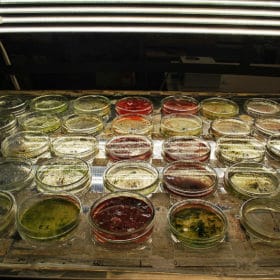Indian researchers develop solar cell from living algae
The researcher team, from Amrita Vishwa Vidyapeetham university in Coimbatore, India, sandwiched macroalgae between a carbon-coated copper electrode and a titanium oxide-coated fluorine-doped tin oxide electrode. The 1 cm2 device exhibited a 1.25 mA photocurrent and 0.5 V photovoltage under UV light.
Algae could boost solar panel efficiency by 4%
A Swedish team has inaugurated a pilot facility to mass produce algae material that can potentially boost silicon solar module efficiency by 4% and thin film by 36%. The algae are added to the encapsulant in silicon-based modules or to the anti-reflective coating on the glass of thin film modules. The team estimates the resulting modules would be 3.9% cheaper.
Ever heard of algovoltaics? Enel is testing it for applications on large solar plants
Nicola Rossi, head of innovation at Enel Green Power, has told pv magazine how the company is seeking to combine microalgae cultivation with solar power generation. The integration scheme is aimed at minimizing interferences with the PV plant and maximizing the benefits in microalgae yield
Researchers at Cambridge University develop new type of two-cell bio-photovoltaics
Researchers have developed and designed a new algae-powered fuel cell that is five times more efficient than existing plant and algal models, as well as having the potential of being more cost-effective to produce and more practical to use.




